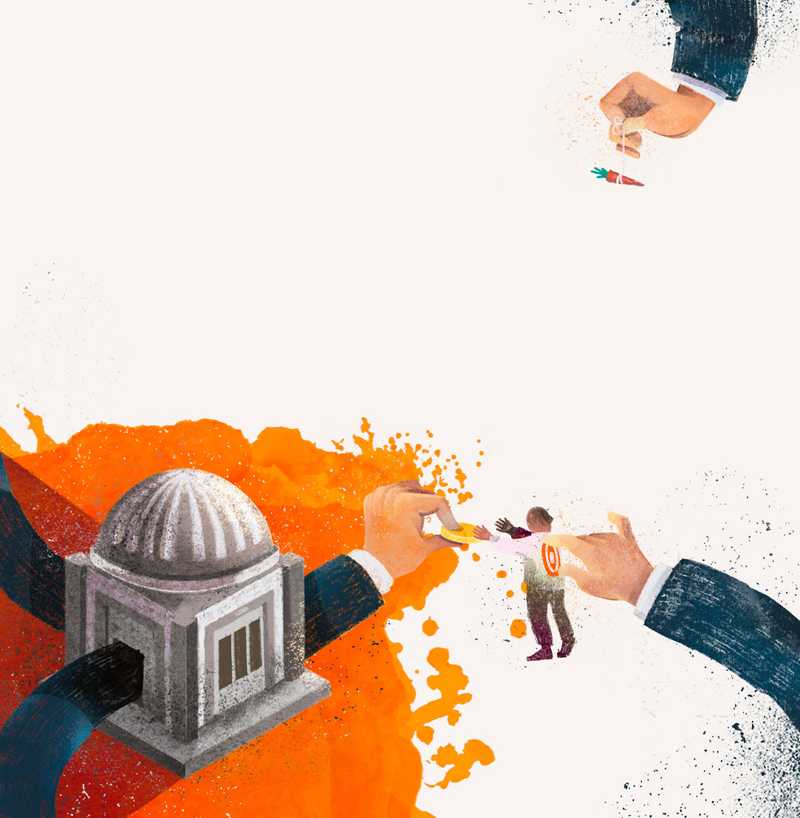This essay is part of the “Debt and Power” series of Progressive International’s Debt Justice Blueprint.
The experience of debt is often one of isolation: month to month, we are alone with our balance sheets, struggling to find the resources to pay back our creditors. But the circuitry of finance actually relies on massive systems of social surveillance. In the name of ‘due diligence’, creditors endeavor to assess a potential borrower’s ability to repay, and if so, at what level of interest. Once a loan has been made, the lender keeps track of their investment and investigates if payments are missed.
In most advanced capitalist societies, this type of surveillance has become normalized, routinized, and embedded into everyday life through the practice of credit scoring. In order for people to be ‘creditworthy’, they must have a large enough economic footprint to be effectively surveilled by credit scoring companies. If they do not, then they must have sufficient assets to use as collateral or find a guarantor with a sufficiently traceable economic history. In this way, debt surveillance frequently extends to the friends and family members of the borrower.
This form of economic surveillance is pervasive and quotidian, with credit scoring corporations and policymakers advancing the narrative that credit-worthiness is a sign of morality and good citizenship. This essay explores how the digitization of the financial sector goes hand in hand with the rise of surveillance capitalism — an insidious form of social control that must be challenged at each step if we are to deliver debt justice.
Localising Surveillance
The establishment of these surveillance networks has required a deep penetration into our societies and down into our communities. Still, credit scoring systems produce patchy coverage and bottlenecks, with marginal segments of society — and particularly those with ‘informal’ livelihoods — unable to be properly surveilled and thus excluded from the formal lending system. This issue became more apparent with the rapid globalization of financialization in conjunction with the ascendance of the neoliberal order in the 1970s and 1980s. Concerns about surveillance capacity were particularly acute in the Global South, where large segments of the population are poor, have no collateral, and operate in informal ‘grey zones’, making it impossible to justify lending to them based on financialized credit-scoring logics.
It is in this context that the microcredit movement emerged, aiming to integrate the unbanked into the formal financial system. And with it, a new type of debt surveillance — referred to as joint liability lending or ‘solidarity lending’ — became the norm. Rather than relying on credit scores or collateral, microloans dispersed liability amongst small groups, with group members vouching for each other. The system was sold to the world as a progressive innovation, rooted in the social capital and mutual trust already existing in local communities. But in effect, the development of joint liability meant that the job of surveillance was displaced from the financial institutions to the borrowers themselves, conveniently reducing transaction costs for lenders along the way.
Key to joint liability lending has been a microfinance ‘civilising’ mission. According to this view, the poor and marginal are backward subjects in need of a modern ‘financial consciousness’, which, once imparted, renders them creditworthy. Progress towards this goal of ‘financial citizenship’ is thus monitored and policed within the group. In the words of the outspoken face of the microcredit movement Muhammad Yunus: ‘Individually, a person tends to be erratic, uncertain in his or her behaviour. But group membership creates group support and group pressure and smooths out behaviour patterns and makes the borrowers more reliable. Subtle, and at times not so subtle, peer pressure keeps the group members in line with the broader objectives of the credit programme.’
As such, joint liability microcredit seeks to embed surveillance within our most intimate relations. It is little surprise that this practice often results in strained interpersonal dynamics within the target communities, as the logic of financialization displaces relations of care and compassion.
Formalizing Property Relations for Surveillance
In the 1990s, the global microfinance industry began to shift from the subsidized, joint liability ‘poverty lending’ model to the ‘financial systems approach’. This was ostensibly to free microcredit providers from the shackles of donor funding, allowing them to become financially sustainable, scale up their business,and reach even poorer and more excluded borrowers. In practice, this transition necessitated the liberalization of interest rates and the adoption of flexible forms of lending, including a move away from joint liability to more traditional credit for individuals based on collateral and guarantors.
In other words, the rise of the financial systems approach represented the transformation of microcredit providers into entities that more closely resembled regular commercial banks. This resulted in a massive influx of global investment that led to the dramatic growth of the microcredit industry worldwide. As such, institutions found themselves yet again facing the problem of how to (cost) effectively assess credit risk for borrowers who had neither a formal financial paper trail nor collateral.
This problem has been largely addressed through concerted attempts to integrate the poor into the formal economic system, transforming them into surveillable subjects — a project that is generally framed through the language of ‘inclusivity’. In particular, efforts have been made to formalize property relations based on the concept of ‘dead capital’, which postulates that informal and collective forms of ownership impede development and growth, keeping populations trapped in poverty.
This has resulted in widespread land titling across the Global South, providing the poor with an asset that can be used as collateral for lending. The formalization of property rights has given large numbers of people living in poverty ‘economic personhood’, making it easier to keep track of them. The sudden conjuring of new assets for the purposes of collateral has allowed financial institutions to expand lending to previously excluded populations, resulting in new and dramatic forms of dispossession. Accumulation for global creditors, in other words, has come at the cost of massive defaults for large numbers of poor people, and in turn their loss of land and livelihoods.
(Financially) Inclusive Surveillance
Over the past decade, alongside the rapid development and growth of the global fintech industry, the microcredit and financial inclusion movement has gone digital. Worldwide there has been a sudden influx of new financial service providers taking advantage of underdeveloped digital regulatory environments and the reduced transaction costs from not needing to maintain physical premises to disperse loans and take savings. Fintech institutions have been at the forefront of ‘financial innovation’, devising innumerable ways to circumvent financial regulations and seek out new sources of profit.
But the fintech ecosystem has also been intimately involved in the emergence of new forms of platform and surveillance capitalism. The digitization of finance has brought big tech and big data into the fold in worrying ways; inclusion in the financial system now requires citizens to acquiesce to intrusive surveillance regimes and the forfeiting of personal data.
Across the Global South, digital financial inclusion has been championed by governments and the development industry alike. For instance, the 2015 World Bank Development Report, entitled Mind, Society, and Behaviour, pushes for the social engineering of good behaviour through ‘tweaks’ and ‘nudges’—ideas popularized by the 2017 Nobel Prize in Economics winner Richard Thaler. This ‘nudge theory’ approach to development has been the justification for social experiments utilizing new forms of financial surveillance that combine personal data and psychometrics, particularly in the Global South. Meanwhile, the Chinese government is developing a ‘social credit’ system (which is currently fragmented and exploratory) aimed at systematically integrating economic and personal data collection to increase ‘trustworthiness’ and ‘integrity’ in society, while also providing the infrastructure to determine who is eligible to borrow from formal financial institutions.
Creditworthiness, Trust, and Surveillance
Contemporary ‘innovations’ in digital lending — and the rapid expansion of the fintech industry more generally — are producing increasingly sophisticated and repressive regimes of big data surveillance and control. These are underpinned by the coercive financialized logic of indebtedness and a corollary moralizing logic of creditworthiness. While the webs of digital surveillance are becoming harder to avoid and more effective in their ability to affect social control, the logics underpinning the system have not fundamentally changed.
Big data and alternative data debt surveillance are merely outgrowths of traditional credit scoring and another step towards the ‘civilising’ project of financial inclusion — a vision of a world inhabited by a financially conscious citizenry, with individuals rendered reliable and trustworthy through their integration into the formal economic system.
A Systemic Transformation of Debt
A vision of debt justice cannot simply tinker with interest rates or introduce new instruments that provide for these communities. It must contend with these massive systems of surveillance, dismantling the infrastructure of social control that makes citizens vulnerable to the twin predations of financial extraction and authoritarian government — and liberate us from a notion of ‘worthiness’ that is predicated on our capacity to pay.
Nicholas Loubere is a member of the Progressive International Debt Justice Collective. He is Associate Professor at the Centre for East and South-East Asian Studies, Lund University. His research examines microcredit and digital finance in rural China, and Chinese migration to Africa for resource extraction.
From the Blueprint team at Progressive International
We live in a world of debt. The depth and breadth of global “debtification” is difficult to overstate. It is the primary contention of this collection that all these disparate dynamics — hedge funds raking in pandemic profits, students struggling to afford an education, micro-borrowers on the brink of bankruptcy — are different manifestations of the same basic structural mechanism at the heart of the global financial system: the endless cycle of privatized gains and socialized losses. Simply put, the rich get richer, while the poor, by design, remain poor.
The goal of this Collective is the goal of progressive movements around the world, to end that cycle. Read the full Debt Justice Blueprint here. If you’re interested in engaging with us, please write to the Varsha Gandikota-Nellutla, Blueprint Coordinator at [email protected].




